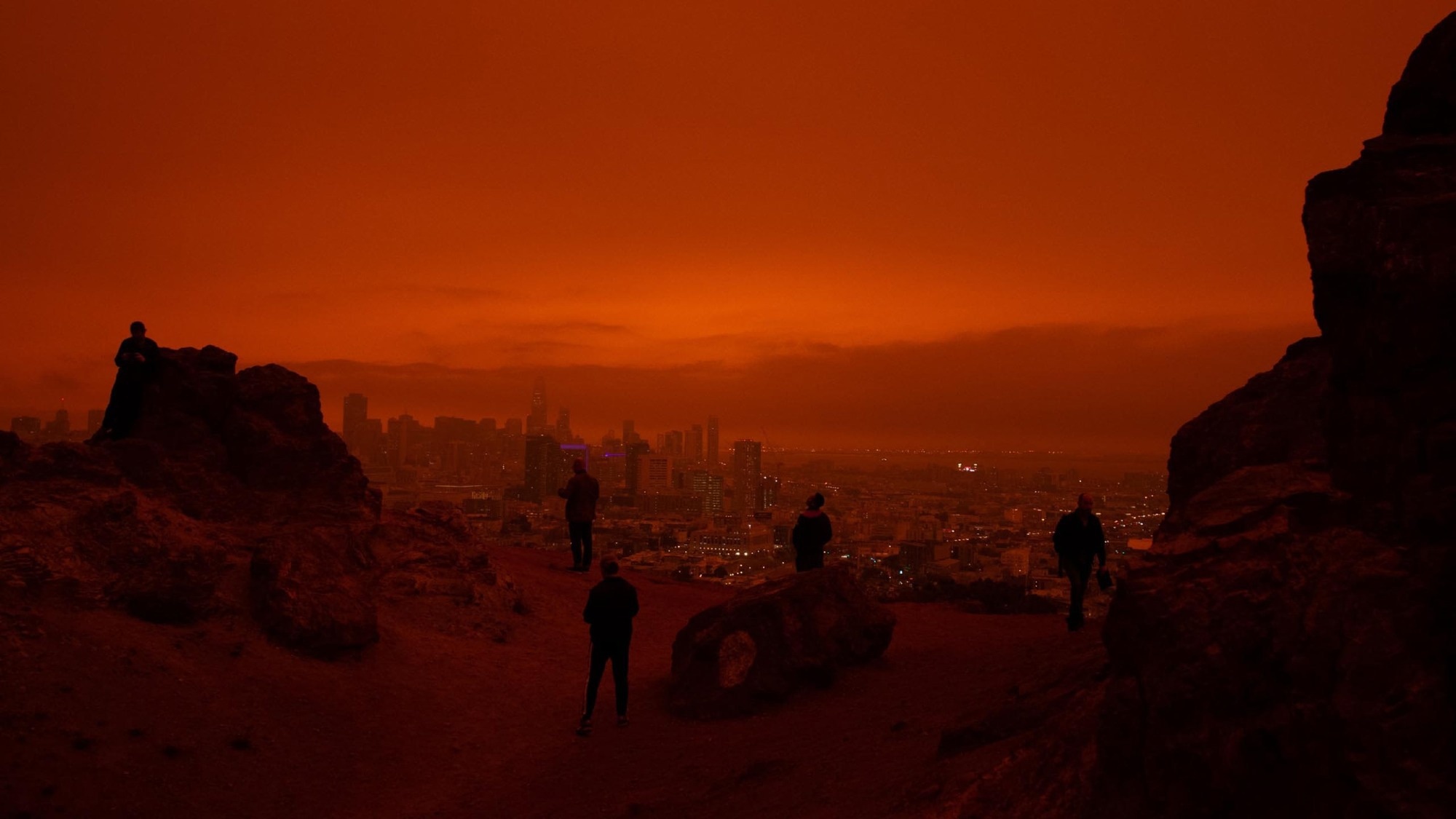Global warming could become “catastrophic” for humanity if temperature increases are worse than anticipated or trigger cascades of events yet to be considered, or indeed both.
 Orange skies over San Francisco during the Californian wildfires of 2020. Image Credit: Patrick Perkins.
Orange skies over San Francisco during the Californian wildfires of 2020. Image Credit: Patrick Perkins.
The possibility of a “climate endgame” needs to be considered, and preparations need to be made.
This is in line with a research agenda put forth by an international team of scientists led by the University of Cambridge for preparing for the bad-to-worst-case scenarios. These contain results that range from a 10% reduction in the world’s population to the eventual extinction of humanity.
The researchers ask the Intergovernmental Panel on Climate Change (IPCC) to devote a future report to catastrophic climate change to spur research and educate the public. The study was published in the journal Proceedings of the National Academy of Sciences.
There are plenty of reasons to believe climate change could become catastrophic, even at modest levels of warming. Climate change has played a role in every mass extinction event. It has helped fell empires and shaped history. Even the modern world seems adapted to a particular climate niche.
Dr. Luke Kemp, Study Lead Author, Centre for the Study of Existential Risk, University of Cambridge
“Paths to disaster are not limited to the direct impacts of high temperatures, such as extreme weather events. Knock-on effects such as financial crises, conflict, and new disease outbreaks could trigger other calamities, and impede recovery from potential disasters such as nuclear war. The catastrophic risk is there, but we need a more detailed picture,” Dr. Kemp added.
Kemp and colleagues assert that there has not been enough research done on the effects of 3 °C warming and higher, as well as the risks associated with it.
According to the team’s modeling, two billion people may live in regions of extreme heat (an annual average temperature of over 29 °C) by 2070. These regions are among the most populous as well as some of the most unstable politically.
Average annual temperatures of 29 degrees currently affect around 30 million people in the Sahara and Gulf Coast. By 2070, these temperatures and the social and political consequences will directly affect two nuclear powers, and seven maximum containment laboratories housing the most dangerous pathogens. There is serious potential for disastrous knock-on effects.
Chi Xu, Study Co-Author, Nanjing University
According to the IPCC study from last year, there is about an 18% risk that temperatures would climb above 4.5 °C if atmospheric CO2 doubles from pre-industrial levels, which the globe is halfway to.
A “text mining” analysis of IPCC reports that Kemp co-authored and had its results published earlier this year revealed that the IPCC assessments had changed from high-end warming and were instead concentrating more on lower temperature increases.
This expands on earlier research he did to demonstrate that scenarios involving severe temperatures are “underexplored relative to their likelihood.”
“We know least about the scenarios that matter most,” Kemp stated.
Famine and starvation, extreme weather, conflict, and vector-borne diseases are the “four horsemen” of the climatic endgame, according to the team behind the PNAS publication, which also includes a research agenda.
According to them, global warming poses a serious threat to the food supply, increasing the likelihood of “breadbasket failures” when the world’s most productive agricultural regions collectively collapse.
The environment for future disease outbreaks could be made worse by hotter and more intense weather as both human and animal habitats change and get smaller.
The authors warn that the collapse of the climate system would probably increase other “interacting dangers,” such as growing inequality, false information, the dissolution of democracy, and even the development of new kinds of dangerous AI weapons.
In one scenario discussed in the paper, technologically advanced superpowers engage in “warm wars” over massive projects to reflect sunlight and lower global temperatures as well as dwindling carbon space.
More attention should be paid to locating all potential “Hothouse Earth” tipping points, including those that could result in the disappearance of cloud cover, the release of methane from permafrost melt, or the loss of forests that serve as “carbon sinks.”
The more we learn about how our planet functions, the greater the reason for concern. We increasingly understand that our planet is a more sophisticated and fragile organism. We must do the math of disaster in order to avoid it.
Johan Rockström, Study Co-Author, Professor and Director, Potsdam Institute for Climate Impact Research
Co-author Professor Kristie Ebi from the University of Washington stated, “We need an interdisciplinary endeavor to understand how climate change could trigger human mass morbidity and mortality.”
Kemp added, “A greater appreciation of catastrophic climate scenarios can help compel public action. Understanding nuclear winter performed a similar function for debates over nuclear disarmament. We know that temperature rise has a ‘fat tail’, which means a wide range of lower probability but potentially extreme outcomes.”
“Facing a future of accelerating climate change while remaining blind to worst-case scenarios is naive risk-management at best and fatally foolish at worst,” Kemp concluded.
Journal Reference:
Kemp, L., et al. (2022) Climate Endgame: Exploring catastrophic climate change scenarios. Proceedings of the National Academy of Sciences. doi.org/10.1073/pnas.2108146119.